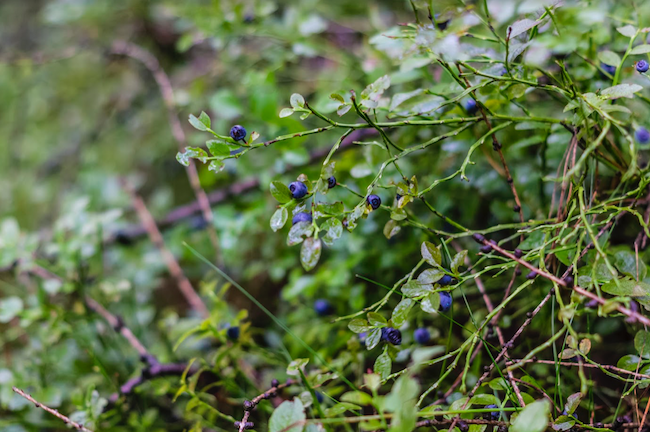
Despite being central to our everyday survival, food is something that’s often missing from our history books. The gathering, domestication, and cultivation of foods has played a large role in shaping human history and will no doubt play a large role in shaping our future as well. These seven native foods have all played a part in North American history.
Blueberries
In precolonial times blueberries were an important crop for Native Americans. They were used fresh, dried for the winter, and frequently used as an ingredient in pemmican. These blueberries were lowbush varieties that grew wild. Today’s domesticated highbush varieties weren’t bred until 1911. At the time, many people believed that the blueberry couldn’t be domesticated. Thankfully Elizabeth White, the daughter of a cranberry grower, and Frederick Coville, a USDA botanist, worked to develop the highbush blueberries we enjoy today.
Ostrich Fern Fiddleheads
Fiddleheads are immature fern fronds that are cut before they unfurl. The variety of fern with edible fiddleheads that’s native to North America is called the ostrich fern. It was harvested wild by Native Americans and is still commonly wild-harvested today. It’s even considered a spring delicacy in some areas.
Strawberries
While there are strawberry varieties native to nearly every temperate region of the world, the strawberries we grow today are a cross between the North American variety Fragaria virginiana, and the South American variety Fragaria chiloensis. Fragaria virginiana can be found growing wild in North America and bears small but flavorful berries. Fragaria chiloensis is native to Chile and produces larger but less flavorful berries than its North American cousin. Both varieties were taken to Europe in the 1700s, where they were grown side by side in many gardens, giving them the opportunity to hybridize and create the modern strawberry Fragaria x ananassa. In the late 1700s, Fragaria x ananassa was brought back to the United States, where growers began breeding improved cultivars.
Sunflowers
Sunflowers were first cultivated by Native Americans in what is now Arizona and New Mexico. Archaeologists have found evidence that they were domesticated as early as 3000 BC! Native Americans used the entire plant for food, medicine, ceremony, and creating dye. The Spanish took sunflowers to Europe around 1500, however they weren’t cultivated commercially until Russia began developing varieties in the late 1700s with increased oil production in mind. These Russian varieties slowly made their way back to the United States, and the early 1900s saw an increase in U.S. sunflower cultivation.

Pecans
Unfortunately much of the pecan tree’s precolonial history is unknown. We do know that it is native to North America and was first cultivated by Native Americans. In fact, its name is derived from the Algonquin word pacane, which describes “nuts requiring a stone to crack.” The colonists were quick to adopt the pecan and began growing it in orchards. However, it wasn’t commercialized until the late 1800s. In 1876 a former African American slave named Antoine developed grafting techniques that allowed growers to create improved cultivars. These techniques were widely adopted in the 1880s and led to improved production.
Turkey
Wild turkeys are native to North America and were an important food source for many indigenous cultures. While they were commonly hunted in what’s now the United States, they were first domesticated in Mexico. They were also brought back to Europe in the early 1500s and were quickly domesticated there for their prize meat. While keeping domesticated turkeys quickly became common, hunting wild turkeys remained popular enough that by the late 1800s they had been almost entirely wiped out. Fortunately, conservation efforts were able to save the species. The 1940s saw an increased focus on domesticated turkey production, and many heritage breeds were left behind. Modern varieties have been bred for the ability to gain weight quickly and bear little resemblance to their wild ancestors or even domesticated heritage varieties.
Highbush Cranberries
These cranberries are native to the northern parts of North America and were valued by Native Americans and colonists as a source of food and medicine. Though they can be eaten raw, wild cranberries are usually cooked into jams, jellies, and sauces. Traditionally the bark of highbush cranberries was used to relieve cramps, which is why the plant is also known by the name “cramp bark.”
These are just seven of the many foods that are indigenous to North America. There are many other food plants native to North America that can be tough to find at the grocery store but are easy to grow at home. Among these are pawpaws, American persimmons, ramps, black walnuts, and hickory nuts. Though these and many other North American foods were never commercialized, they still hold value. In a changing world, biodiversity is an important part of sustainable agriculture. Many of these food plants are more resistant to native pests and diseases and more adaptable to local climate conditions than foreign crops.
Jordan Charbonneau is an organic farmer and writer from West Virginia. She holds degrees in ecology and environmental humanities from Sterling College in Vermont.



